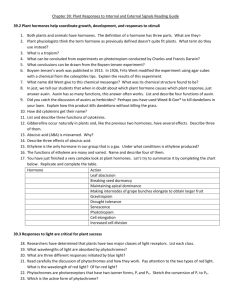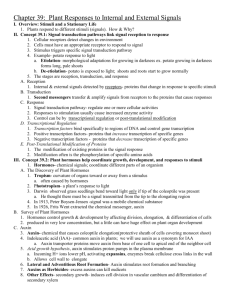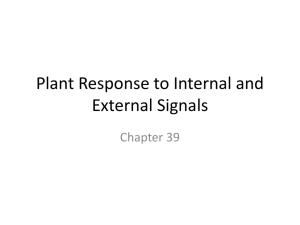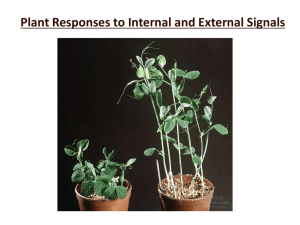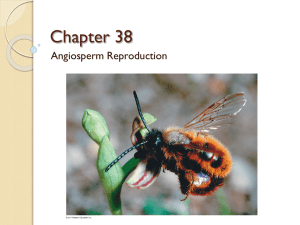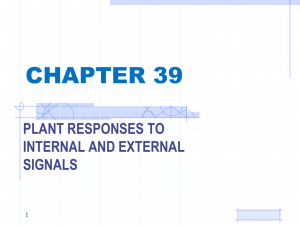Chapter 39 Plant Responses to Internal and External Signals Shawn Koshy
advertisement
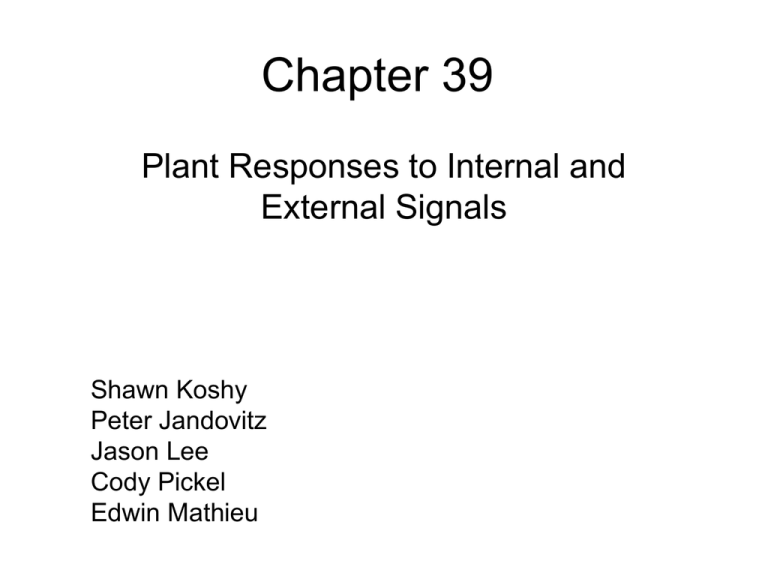
Chapter 39 Plant Responses to Internal and External Signals Shawn Koshy Peter Jandovitz Jason Lee Cody Pickel Edwin Mathieu Concept 39.1: Signal transduction pathways link signal reception to response • All organisms receive specific environmental signals and respond to them in ways tat enhance survival and reproductive success. • Responses caused by stimuli can nly happen through certain receptors on cells. • Etiolation: morphological plant adapttions for growig in the darkness. • De-etiolation: the changes a plant shoot undergoes in response to sunlight; also known informally as greening. Reception • Receptors, or proteins that undergo conformational changes in response to a specific stimulus, are the first to detect signals. • Phytochrome: the receptor involved in de-etiolation (photoreceptor). Transduction • Second messengers: small internally produced chemicals that transfer and amplify the signal from the receptor to other proteins that cause the response. • For example, signal transduction in plants begin by the detection of the light signal by the phytochrome receptor, which activates at least 2 signal transduction pathways. • One pathway uses cGMP as a second messenger that activates a specific protein kinase. • The next pathway causes an increase in cytoplasmic Ca2+ levels, ultimately activating another protein kinase. • Lastly, both pathways will result in an expression of genes for proteins that function in the de-etiolation response (greening). Response • A signal transduction pathway leads to regulation of 1 or more cellular activities. • There are 2 main mechanisms by which an enzyme can be activated by a signal pathway: – Transcription Regulation: stimulates transcription of mRNA for the enzyme. – Post-Translational Modification: activates existing enzyme molecules. Transcription Regulation • Transcription factors bind directly to particular regions of DNA and control the transcription of certain genes. • The activation of positive or negative or both types of transcription factors has an affect on the mechanism by which a signal promotes a new developmental course. Post-Translational Modification of Proteins • The post-translational modification of existing proteins is as important as the syntheses of new proteins by transduction and translation. • Chains of phosphorylated protein kinases can result in signal pathways ultimately regulating the synthesis of new proteins (turning genes on and off). • Protein phosphatases: enzymes that dephosphorylate specific proteins (“switch-off” processes). De-Etiolation (“Greening”) Proteins • Enzymes that are involved in photosynthesis directly, and enzymes involved in supplying the chemical precursors for chlorophyll production, and many more also effect hormones that regulate plant growth. • These are either newly transcribed or activated by phosphorylation during the de-etiolation process. 39.2: Plant hormones help coordinate growth, development, and responses to stimuli • Tropism- response that causes changes in growth away from or toward stimuli ex) phototropism- growth towards light • Tropisms are caused by hormoneschemical signals in an organisms Discovery of Plant Hormones • In the late 19th century, Charles and Francis Darwin discovered that a phototropic response could only be triggered when light could reach the tip of the coleoptile. • Boysen-Jensen observed that a phototrophic response was triggered by a light- activated mobile chemical • Later modified experiments by Frits Went led to the discovery of auxin. Survey of Plant Hormones Hormone Major Functions Auxins At lower concentrations, stimulates cell elongation by increasing the activity of proton pumps; at higher concentrations, it inhibits cell elongation. Lateral and adventitious root formation and branching. Induces xylem differentiation in developing plants. Promotes the growth of fruits. Can be used as herbicides for broadleaf plants. Cytokinins Produced in the roots and fruits, and spread throughout the plant, working with auxin to stimulate cell division and differentiation. Works against auxin in controlling apical dominance. Giberellin s Signals a young embryo to break dormancy and begin germination. Stimulate growth of both leaves and stems, especially in bolting, rapid growth of the floral stalk. Stimulates cell elongation by inducing enzymes that facilitate the expansins that loosen cell walls. Used commercially to enhance development and growth of fruits. Plant Hormones (cont’d) Hormone Major Functions Brassinosteroi Induce cell elongation and division in stem segments and d seedlings at low concentrations. Retard leaf abscission and promote xylem differentiation. Abscisic Acid Increases in levels to promote seed dormancy . Internal signal that enables plants to withstand drought. Under excessive drought, causes stomata to close rapidly, reducing transpiration. Ethylene Produced in response to mechanical stresses such as drought, flooding, mechanical pressure, and infection. Instigates the triple response when seed growth reaches an obstacle. Increased levels associated with apoptosis, the programmed destruction of organs or tissues in the plant. Leaf abscission controlled by a balance of auxin and ethylene (higher ethylene levels promote leaf abscission). Ethylene triggers fruit ripening, which in turn triggers more ethylene through positive feedback. Figure 1: Triple Response Caused by Ethylene The growing shoot on the left undergoes the triple response, resulting in a slowing of stem elongation, thickening of the stem, and a curvature of the stem that causes it to grow horizontally. The growing shoot on the right is under control conditions, and continues to grow vertically. Figure 2: Commercial Use of Gibberellins for Fruit Production The picture on the right shows how gibberellins enhance the development and growth of fruits. The grapes on the right were grown with daily spraying of gibberellins. Thompson grapes are an example of hoe gibberellins are used in industry to increase the size, taste and overall worth of fruits to the consumer. System Biology and Hormone Interactions • Interactions between hormones and their signal transduction pathways makes it difficult to predict the effect of genetic engineering on a plant. • Systems biology strives for better, in-depth knowledge of plants that will grant better view of these interactions, making genetic engineering more effective. Concept 39.3: Responses to light are critical for plant success • Effects of light on plant morphology are what plant biologists call photomorphogenesis • Light causes many key events in plant growth and development • There are two major classes of light receptors: blue-light photoreceptors and phytochromes, which absorb mostly red light EXPERIMENT Researchers exposed maize (Zea mays) coleoptiles to violet, blue, green, yellow, orange, and red light to test which wavelengths stimulate the phototropic bending toward light. The graph below shows phototropic effectiveness (curvature per photon) relative to 1.0 effectiveness of light with a wavelength of 436 nm. 0.8 The photo collages show coleoptiles before and after 0.6 90-minute exposure to side lighting of the indicated colors. 0.4 Pronounced curvature occurred 0.2 only with wavelengths below 500 nm and was greatest with 0 blue light. 450 500 550 600 650 700 400 Phototropic effectiveness relative to 436 nm RESULTS Wavelength (nm) Light Time = 0 min. Time = 90 min. CONCLUSION The phototropic bending toward light is caused by a photoreceptor that is sensitive to blue and violet light, particularly blue light. • An action spectrum depicts the relative effectiveness of different wavelengths of radiation in driving a particular process Blue-Light Photoreceptors • Blue-light receptors initiate diverse responses in plants including: • The light induced opening of stomata • The light-induced slowing of hypocotyl elongation that occurs when a seedling breaks ground • Phototropism Phytochromes as Photoreceptors • Phytochromes are responsible for many of a plant’s responses to light throughout its lifetime • De-etiolation is regulated by phytochromes Phytochromes and Seed Germination • Phytochromes were discovered during studies of seed germination • In the 1930s, scientists at the U.S. Department of Agriculture determined the action spectrum for light-induced germination of lettuce seeds EXPERIMENT During the 1930s, USDA scientists briefly exposed batches of lettuce seeds to red light or far-red light to test the effects on germination. After the light exposure, the seeds were placed in the dark, and the results were compared with control seeds that were not exposed to light. The bar below each photo indicates the sequence of red-light exposure, far-red light exposure, and darkness. The germination rate increased greatly in groups of seeds that were last exposed to red light (left). Germination was inhibited in groups of seeds that were last exposed to far-red light (right). RESULTS Dark (control) Red Dark Red Far-red Red CONCLUSION Red Far-red Dark Dark Red Far-red Red Far-red Red light stimulated germination, and far-red light inhibited germination. The final exposure was the determining factor. The effects of red and far-red light were reversible. • Figure 3: Phytochromes exist in two photoreversible states - Pr and Pfr Pr Pfr Red light Responses: seed germination, control of flowering, etc. Synthesis Far-red light Slow conversion in darkness (some plants) Enzymatic destruction Phytochromes and Shade Avoidance • The phytochrome system also provides the plant with information about the quality of light • In a shade avoidanc response of a tree, the phytochrome ratio shifts in favor of Pr Biological Clocks and Circadian Rhythms • Many plant processes oscillate during the day • Ex: Transpiration • Synthesis of certain enzymes • Figure 4: Some plants lower leaves in the evening and raise them in the morning Noon Midnight • Cyclical responses with a frequency of about 24 hours and not directly paced by environmental variables are called circadian rhythms • approximately 24 hours long • can be made to be exactly 24 hours by the day/night cycle The Effect of Light on the Biological Clock • Phytochrome conversion marks sunrise and sunset • This provides the biological clock with environmental cues Photoperiodism and Responses to Seasons • Photoperiod - the relative lengths of night and day • Many plants use the photoperiod to detect the time of year • Photoperiodism - a physiological response to photoperiod Photoperiodism and Control of Flowering • Some developmental processes require a certain photoperiod • Short-day plants flower in fall or winter due to the shorter day lengths and longer nights • Long-day plants flower in late spring or early summer do to the long hours of daylight. • Day-neutral plants are unaffected by photoperiod and flower regardless of daylength Critical Night Length • In the 1940s, researchers discovered that responses to photoperiod are controlled by night length, not day length During the 1940s, researchers conducted experiments in which periods of darkness were interrupted with brief exposure to light to test how the light and dark portions of a photoperiod affected flowering in “short-day” and “long-day” plants. EXPERIMENT RESULTS Darkness Flash of light Critical dark period Light (a) “Short-day” plants flowered only if a period of continuous darkness was longer than a critical dark period for that particular species (13 hours in this example). A period of darkness can be ended by a brief exposure to light. (b) “Long-day” plants flowered only if a period of continuous darkness was shorter than a critical dark period for that particular species (13 hours in this example). The experiments indicated that flowering of each species was determined by a critical period of darkness (“critical night length”) for that species, not by a specific period of light. Therefore, “short-day” plants are more properly called “long-night” plants, and “longday” plants are really “short-night” plants. CONCLUSION A Flowering Hormone? • The flowering signal, not yet chemically identified is called florigen • It may be a ormone or change in relative concentrations of multiple hormones Meristem Transition and Flowering • The outcome of the combination of environmental cues and internal signals is the transition of a bud’s meristem from a vegetative to a flowering state Section 39. 4: Plants respond to a wide variety of stimuli other than light Gravity • • • • • Gravitropism is a response to gravity. Gravitropism functions as soon as the seed germinates ensuring that the root grows into the soil and the shoot reaches sunlight regardless of how the seed happens to be oriented in the soil Gravitropism may be either positive (toward) or negative (away from). – In their responses to gravity, roots display positive gravitropism and shoots exhibit negative gravitropism The curvature that occurs in reaction to gravity is due to differences in cell elongation on the opposite sides of a root or shoot. The molecule called auxin promotes cell elongation in shoot and inhibits it in roots. Gravity (cont.) • • • • Plants may detect gravity by the settling of statoliths, specialized plastids containing dense starch grains, to the lower portions of cells According to one hypothesis, the settling of statoliths in cells of the root cap triggers movement of calcium, which causes the lateral transport of auxin. The calcium and auxin accumulate on the lower side of the growing root, where the high concentration of auxin inhibits cell elongation, causing the root to curve downward. The settling of the protoplast and large organelles may distort the cytoskeleton and also signal gravitation direction. Figure #5: Positive gravitropism in roots: the statolith hypothesis Mechanical Stimuli • Thigmomorphogenesis refers to the morphological changes in its form that result from mechanical stress – Plants are very sensitive to mechanical stress • Mechanical stimulation activates a signal transduction pathway that increases the cytosolic Ca2+ , which in turn mediates the activation of specific genes, some of which encode for proteins that affect cell wall properties. • Rubbing the stems of a young plant a couple of times daily results in plants that are shorter than controls (see Figure #2) Figure #6: Thigmomorphogenesis Mechanical Stimuli (Cont.) • • Thigmotropism is the directional growth as a response to contact with a solid object For example, when the compound leaf of the sensitive plant Mimosa pudica is touched, it collapses and its leaflets fold together (see Figure #3) – This response is due to the rapid loss of turgor by cells in specialized motor organs called pulvini, located at the joints of the leaf – These cells lose potassium when stimulated, resulting in osmatic water loss. • The message travels through the plant from the point of stimulation, perhaps as the result of electrical impulses, called Action potentials Figure #7: • Thigmotropism Environmental Stresses • Drought • Water deficit in a leaf causes guard cells to lose turgor, a simple control mechanism that slows transpiration by closing stomata • stimulates increased synthesis and release of abscisic acid in the leaf, and this hormone helps keep stomata closed by acting on guard cell membranes. • inhibits the growth of young leaves, minimizing the transpirational loss of water by slowing the increase in leaf surface • Inhibits the growth of shallow roots while deeper roots in moist soil continue to grow Environmental Stresses (Cont.) • Flood • The air spaces of flooded soil lack the oxygen needed for the cellular respiration of the roots • Oxygen deprivation stimulates the production of the hormone ethylene, which causes some of the cells in the root cortex to undergo apoptosis (programmed cell death). • Enzymatic destruction of cells creates air tubes that function as “snorkels,” providing oxygen to the submerged roots Environmental Stresses (Cont.) • Salt Stress • Lowers the water potential of the soil solution below that of roots, causing the roots to lose water • sodium and certain other ions are toxic to plants when their concentrations are relatively high – The selectively permeable membranes of root cells prevent the uptake of most harmful ions, but this only aggravates the problem of acquiring water from hypertonic soil. • Plants may respond to moderate soil salinity by producing compatible solutes that lower the water potential of root cells. • Halophytes- salt tolerant plants that have salt glands that pump salts out across the leaf epidermis Environmental Stresses (Cont.) • Heat Stress • Excessive heat can harm and eventually kill a plant by denaturing its enzymes and damaging its metabolism in other ways • Transpiration creates evaporative cooling for a plant, but this effect may be lost on hot, dry days when stomata close to reduce water loss • In high temperatures, plant cells produce heat-shock proteins that may provide temporary support to reduce protein denaturation. Environmental Stresses (Cont.) • Cold Stress • Plants respond to cold stress by increasing the proportion of unsaturated fatty acids in membrane lipids in order to maintain the fluidity of cell membranes. • At subfreezing temperatures, ice forms in the cell walls and intercellular spaces of most plants, lowering the extracellular water potential and causing cells to dehydrate • Plants adapted to cold winters have special adaptations that enable them to cope with freezing stress, such as changing the solute composition of the cytosol 39.5: Plants defend themselves against herbivores and pathogens • Plants do not exist in isolation but interact with many species. • While some of these interactions can be beneficial, most are harmful and dangerous to the plant. • As a producer plants are the base of most food webs and subject to attack by a wide range of animals, as well as infection by pathogenic viruses, bacteria, etc. Defenses Against Herbivores • Many plants have physical defenses, such as thorns, and chemical defenses, such as toxic compounds • Some plants recruit predatory animals that prey on specific herbivore by releasing volatile chemicals which attract the predator. • Volatile chemicals also serve as an alert for nearby plants, which allow them to activate genes for plant defense ex) jasmonic acid Defenses Against Pathogens • Virulent – host plant has little defense against pathogen. • Avirulent- pathogen able to harm, but not kill, host plant. 1) Gene-for-gene recognition- recognition of pathogen derived molecules by the protein products of specific disease resistant (R) genes. – R proteins recognize pathogen molecules encoded from avirulence (Avr) genes, which play a role in the infection of pathogen. Defenses (cont’d) 2) Plant Responses - Elicitors- induce broader type of host defense; stimulate phytoalexins, antimicrobial compounds - PR proteins- spread signals to nearby cells, as well as aid in attacking pathogens - Cross linking of cell walls and release of lignin, which produces a barricade to prevent further infection Hypersensitive Response (HR)- enhance production of elicitors and PR proteins Systemic Acquired Resistance (SAR) • Chemical signals sent throughout whole plant, stimulating production of phytoalexins and PR proteins; coupled with HR. • Salicylic acid- main hormone attributed to SAR
